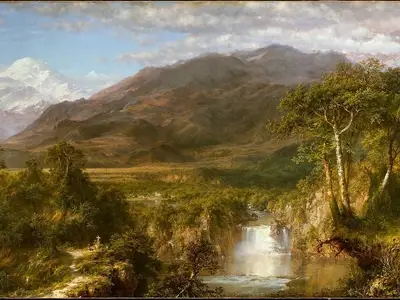Title of Artwork: “Heart of the Andes”

Artwork by Frederic Edwin Church
Year Created 1859
Summary of Heart of the Andes
The Heart of the Andes, a huge oil-on-canvas painting by Frederic Edwin Church.
It shows an idealising scene at more than 5 feet high and almost 10 feet broad. In South American Andes, where Church had visited on two times. His show in 1859 was a sensation, and the picture established Church as America’s leading landscape painter. It has been in the New York Metropolitan Museum of Art collection since 1909 and is one of the most famous works of the Church.
All About Heart of the Andes
This is the biggest and most important job Church did between 1853 and 1857 after two trips to South America. The picture is three metres wide and has a fauna spring, particularly in the front, where many plants are detailed. The cluster of silver-coloured trees to the right is a location of intense visual appeal. Their roots stretch dangerously over the centre water pool into the thin air. Curious details such as these must certainly be based on firsthand observation and help create a unique visual intensity that is currently present in just a small number of other artists’ works.
The travels to the Andes in the Church were inspired partially by the naturalist and polymath Alexander von Humboldt, whose early 19th-century South American travel journal was renowned for his work at the time of the Church. On the 9th of May 1859, Frederic wrote to his friend that he wanted the newly finished painting of The Heart of the Andes to be sent to Germany in order to provide “a transcript of the scenery which delighted his eyes sixty years ago.” to elderly Humboldt. This implies that the Church saw the painting of the countryside, at least partially, as a way of transmitting to the spectator a feeling true to the initial experience with the area. However, in his reproduction of specific landscapes, he was not fully genius to this goal. Key components appear to follow the norms of the romantic landscape rather than the specifics of geography, for example, the layering of the foreground (the detailed plants), the central ground (the jungle, the plane) and the backdrop (the towering rugged mountains). Nevertheless, Church used these norms well and took his photos from a number of precise drawings.
Ironically, on 6 May 1959, only three days before Church had sent his letter to his buddy, Humboldt died. However, when we look at The Heart of the Andes, we get a focused and exaggerated feeling of what the lonely traveller might have felt at the first meeting with the great ridges and peaks of the South American interior.
Information Citations
En.wikipedia.org, https://en.wikipedia.org/.
























